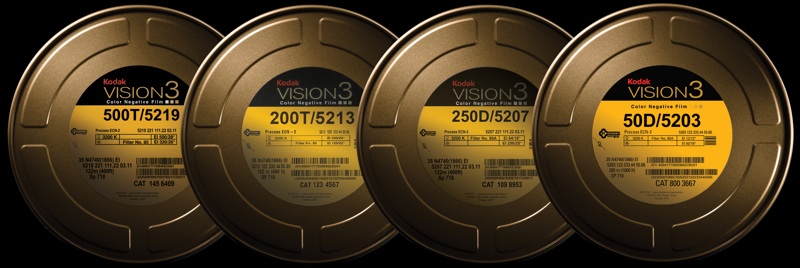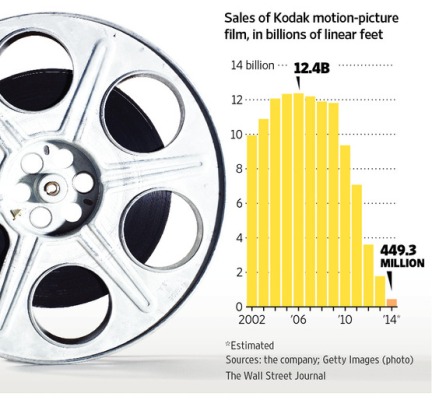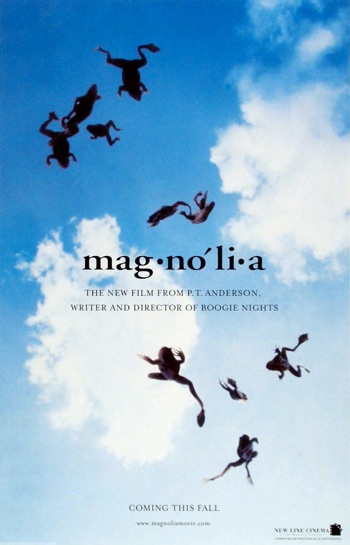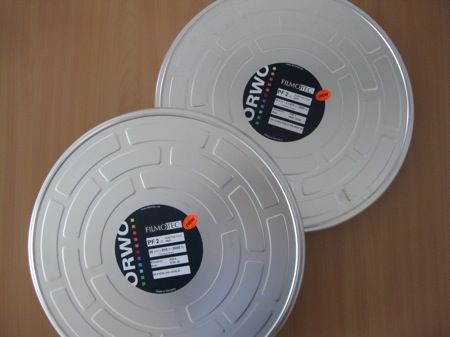
The celluloid community received its first positive news in recent months when the Wall Street Journal reported on Tuesday that a consortium of studios was negotiating a long-term arrangement with Eastman Kodak Co. to maintain the company’s film manufacturing capacity. The Hollywood Reporter followed up Wednesday with word that the deal was “all but finalized.”
The situation is, of course, rich in irony. The negotiating studios—Warner Bros., Universal, Paramount, Disney, and the Weinstein Company—have been trying for more than a decade to wean their industry away from these very film products, which built and sustained Hollywood over the last century. Kodak, meanwhile, had been striving to transform itself into a desktop printing company under the tenure of recently-departed CEO Antonio Perez, despite the fact that motion picture film remained the declining company’s only profit center. (Speaking of profits, it’s hard to decide which Journal take-away is more astonishing: that Kodak’s film orders had declined by 96% since 2006 or that the film unit was still in the black throughout much of this death spiral. Only in March 2014 did newly-installed Kodak CEO Jeff Clarke discover that demand was dropping sufficiently to threaten film’s profitability. If film manufacture truly remained profitable operating at 15% capacity, perhaps it was a better business proposition than anyone guessed.)
After years of friendly nudges, financial incentives, and outright threats from the studios agitating for full digital conversion, it’s certainly odd to read Warner Bros. CEO Kevin Tsujihara quoted in the Journal as follows: “In an industry where we very rarely have unanimity, everyone has rallied around keeping film as an option for the foreseeable future.” What accounts for the sudden charge of heart?
The pressure came from many of Hollywood’s top filmmakers, specifically Christopher Nolan, Quentin Tarantino, J. J. Abrams, and Judd Apatow. All are in the midst of planning, shooting, or finishing major film-centric projects like Interstellar and Star Wars Episode VII (both of which are using conventional 35mm alongside IMAX film).
 While digital projection has achieved near-complete penetration in American multiplexes, film has proven surprisingly resilient as a production medium. Major film features and even television programs are still shot on 35mm or Super 16—and not just the most celebrated or artiste-driven either. Tammy was shot on 35mm. So were big-budget, CGI-heavy action films like Edge of Tomorrow and The Amazing Spider-Man 2, which would seem like natural candidates for an integrated, fully-digital capture and workflow. To date, no wholly-digital production has won the Academy Award for Best Picture. (Slumdog Millionaire, which combined analog and digital cinematography, won in 2009, but in subsequent years the old-fashioned film production has always beat out its emblematically born-digital competition: THe Hurt Locker over Avatar, The King’s Speech over The Social Network, The Artist over Hugo, Argo over Life of Pi, and most recently 12 Years a Slave over Gravity.)
While digital projection has achieved near-complete penetration in American multiplexes, film has proven surprisingly resilient as a production medium. Major film features and even television programs are still shot on 35mm or Super 16—and not just the most celebrated or artiste-driven either. Tammy was shot on 35mm. So were big-budget, CGI-heavy action films like Edge of Tomorrow and The Amazing Spider-Man 2, which would seem like natural candidates for an integrated, fully-digital capture and workflow. To date, no wholly-digital production has won the Academy Award for Best Picture. (Slumdog Millionaire, which combined analog and digital cinematography, won in 2009, but in subsequent years the old-fashioned film production has always beat out its emblematically born-digital competition: THe Hurt Locker over Avatar, The King’s Speech over The Social Network, The Artist over Hugo, Argo over Life of Pi, and most recently 12 Years a Slave over Gravity.)
Clearly, there is still a core group of Hollywood professionals who prefer film—and recent efforts like The Master (65mm), Moonrise Kingdom (Super 16), The Paperboy (Super 16), The Immigrant (35mm), and Boyhood (35mm)demonstrate that there’s still aesthetic vitality and innovation to be mined from the medium. (Ironically, in the case of the latter two, the directors have ordered 35mm prints for their personal collections, though film presentations of The Immigrant and Boyhood for the general public are few and far between.)
The fact that top Hollywood filmmakers banded together to sustain the film medium is obviously gratifying, but it raises a few uncomfortable questions. A filmmaker like Christopher Nolan has considerable leverage when assembling deals. A studio might not be inclined to produce 35mm and 70mm prints of Interstellar on its own, but would any executive really fight Nolan over such a comparatively minor expenditure when the prospect of Inception-sized international box office hangs in the balance?
But what about a less commercially successful filmmaker like Paul Thomas Anderson or James Gray, whose projects have much more difficulty securing financing in the first place? Surely the cost of raw film stock will not go down following the Kodak pact: if anything, film’s niche status will entail added production costs that sympathetic producers will need to justify over and over to skeptical financiers. Will the much-prized “35mm look” even be available to independent filmmakers or students learning their cinematographic chops? (The Journal quotes the dean from School of Cinematic Arts at USC, who reports that only one production class still uses film.)
 Ultimately, economy of scale is the primary issue—and it’s an issue that the production side of the industry can’t solve on its own. In 2006, Kodak sold 12.4 billion feet of film; this year, their sales projection is only 449.3 million feet, a differential that no filmmaker can bridge.
Ultimately, economy of scale is the primary issue—and it’s an issue that the production side of the industry can’t solve on its own. In 2006, Kodak sold 12.4 billion feet of film; this year, their sales projection is only 449.3 million feet, a differential that no filmmaker can bridge.
A feature production crew typically shoots about four to ten times as much footage as winds up in the final cut. A two-hour feature comprises nearly 11,000 feet of film, so assume that the unedited, raw footage might amount to an order of 44,000 to 110,000 feet of stock from Kodak. Elaborate post-production methods that once required lots of raw stock—such as special effects shots composited layer by layer in an optical printer—have largely been replaced by digital techniques. The days of making endless answer prints to tweak the contrast and color in each shot are over, supplanted by the digital intermediate process where all grading is performed with minimal waste on a computer workstation. Point being, modern productions shot on celluloid would require a modest amount of raw film stock—probably around a few hundred thousand feet. Some especially ambitious and unruly projects like Anderson’s Magnolia proudly consumed a million feet of film during production, but they’re the exceptions that few producers would want to emulate.
Compare those production figures with the print runs that would’ve been required for domestic distribution only five or six years ago. How to Train Your Dragon 2 probably didn’t use a foot of 35mm film in its production process, but if one print of this film had been made for each of the 4,253 North American theaters where it opened on June 13, DreamWorks Animation would have needed to order around forty million feet of filmfrom Kodak. (Many venues would have played Dragon on multiple screens, necessitating two or three prints, but let’s keep it conservative for the sake of argument.)
So, what would really save Kodak—an outstanding feature film proudly shot on 35mm but distributed digitally, or an animated cartoon created digitally that incidentally required millions and millions of feet of film to reach theater audiences?
 Of course, not all film is created equal, and that’s the nub of the issue. The film used in the camera is not the same kind of film run through the projector. At its height, Kodak produced a variety of very specialized stocks, with emulsions designed to accommodate some very specific production needs—high contrast camera stocks, low contrast duplication stocks, emulsions formulated for sound work, telecine transfer, or digital recording. When film was king, Kodak could confidently manufacture bulk quantities of emulsions that none but the most specialized clients even knew about. How many Hollywood types ever heard of Kodak Video News Film 7239, the now-discontinued 16mm emulsion beloved by military clients for its surveillance and reconnaissance potential?
Of course, not all film is created equal, and that’s the nub of the issue. The film used in the camera is not the same kind of film run through the projector. At its height, Kodak produced a variety of very specialized stocks, with emulsions designed to accommodate some very specific production needs—high contrast camera stocks, low contrast duplication stocks, emulsions formulated for sound work, telecine transfer, or digital recording. When film was king, Kodak could confidently manufacture bulk quantities of emulsions that none but the most specialized clients even knew about. How many Hollywood types ever heard of Kodak Video News Film 7239, the now-discontinued 16mm emulsion beloved by military clients for its surveillance and reconnaissance potential?
Smaller companies have pledged to keep motion picture film on the market, but they have no illusion about producing anything resembling the diversity and variety once offered by Kodak. Orwo has sustained itself through large black-and-white stock orders from the Library of Congress, but has no plans to produce color emulsion.
Still photography blogger Vox summed up the daunting calculus very well in 2011:
Among the tidbits found [in the book Making Kodak Film] is the actual size of a Kodak production run, once they’ve set the machines to coat a particular emulsion type. The clear film base is manufactured in rolls 54″ wide; and a roll can be up to two miles long. (No doubt this varies a bit based on its thickness.) After applying all the emulsion layers, drying them, and winding up the completed film, this is known as a “master roll” and it goes on to the slitting and packaging stages.
That’s a huge amount of film—more than an acre. […] If it takes Kodak more than a year to sell that much of a particular emulsion, the likelihood they’ll coat another master roll becomes extremely doubtful.
Kodak built their immense, sophisticated, Building 38 production line in 1990. It helped them keep costs low at a time when the world was still buying film by the mile for their family & holiday snaps. But today, that massive plant has become something of an albatross. It means a particular film type is toast, once sales drop below a certain threshold.
The recent Kodak announcement will save a few 35mm color negative emulsions, but what about the rest? What about black-and-white camera stock? What about 35mm print stock? What about 16mm in all its varieties? Or 70mm? Or Super 8?
The uncomfortable fact that must be acknowledged is that our cherished cinema was never the creation of a singular, visionary filmmaker, but an interconnected form of industrialized, collective action. The network of twentieth century film users also was much larger, and thus more stable, than just Hollywood: industrial filmmakers, home movie mavens, advertising firms, educators, and religious groups all found unique applications for this endlessly flexible technology.
Perhaps film’s best hope in the twenty-first century lies outside the realm of cinema entirely. Kodak has already announced plans to partner with Kingsbury Corp., another nineteenth century behemoth recently emerged from bankruptcy, to produce a resilient film for the touchscreens of smart phones and tablets the world over. We can only hope that film has hitherto unrecognized utility as a home insulation material or perhaps a health care product. Salvation seekers can’t be too particular.
